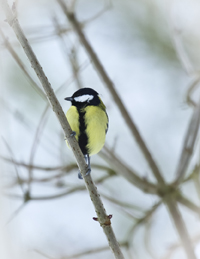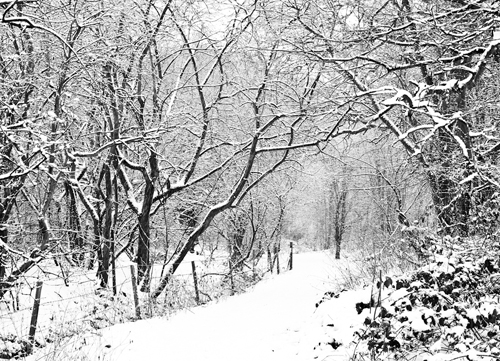by Sarah Walters of Alvecote Wood
Click here to read more articles by Sarah on SoW.
 The woods look fantastic in the snow – a world transformed by snow and ice into a fairyland of wonder. All around us are the signs of the struggle nature has at this time of year – the busy seed feeders, tracks in the snow, food caches being dug up and consumed, the occasional evidence of predation. It is a hard time of year.
The woods look fantastic in the snow – a world transformed by snow and ice into a fairyland of wonder. All around us are the signs of the struggle nature has at this time of year – the busy seed feeders, tracks in the snow, food caches being dug up and consumed, the occasional evidence of predation. It is a hard time of year.
It is perhaps easier to appreciate an acute threat, such as snow and ice, than an insidious threat, but it is there, nonetheless. The renowned writer on management, Charles Handy, used a metaphor in his books about the boiling frog. If you put a frog into hot water it will jump out, but if you put it in cold water and heat it gradually, it will be boiled to death (I believe this is not true, but it is a good metaphor). Not a nice thing to happen to a frog, but the same thing is in danger of happening to our natural environment. We can appreciate, worry about, and try to solve an acute crisis, but we become habituated to the gradual loss and erosion of biodiversity and environment until we become aware it has gone, and gone for good.
 What are these threats? They are so common and ubiquitous that we don’t even see or appreciate them happening. But they are there, and it all boils (pardon the pun) down to policy. And we have a lot of new policies kicking in at present. Reform of the Common Agricultural Policy (including farm subsidies), the Natural Environment White Paper (failure to protect ancient woodland), the National Planning Policy Framework (failure to explicity protect anything other than species and habitats protected under European legislation). Then there is Biodiversity Offsetting – the idea that you can rip up habitat in one place, and replace it in another – the more valuable the habitat, the higher it scores, but you can replace a little high-scoring habitat with a lot of low-scoring less-valuable habitat. But nature doesn’t work that way. There is the drive to industrialise agriculture, with the threat of mega-farms and mega-dairies, and the loss of hedgerows and habitats that this involves to provide fodder crops. Ownership of land is concentrated in ever-fewer hands, and subsidies frequently go not to those who farm and care for the land, but large landowners. Councils are selling off their farms – one of the few routes into farming for the non-wealthy. People are progressively distanced from the countryside, and the land, and farming, and forests – it is a place to visit, not a place to live, and breathe, and experience.
What are these threats? They are so common and ubiquitous that we don’t even see or appreciate them happening. But they are there, and it all boils (pardon the pun) down to policy. And we have a lot of new policies kicking in at present. Reform of the Common Agricultural Policy (including farm subsidies), the Natural Environment White Paper (failure to protect ancient woodland), the National Planning Policy Framework (failure to explicity protect anything other than species and habitats protected under European legislation). Then there is Biodiversity Offsetting – the idea that you can rip up habitat in one place, and replace it in another – the more valuable the habitat, the higher it scores, but you can replace a little high-scoring habitat with a lot of low-scoring less-valuable habitat. But nature doesn’t work that way. There is the drive to industrialise agriculture, with the threat of mega-farms and mega-dairies, and the loss of hedgerows and habitats that this involves to provide fodder crops. Ownership of land is concentrated in ever-fewer hands, and subsidies frequently go not to those who farm and care for the land, but large landowners. Councils are selling off their farms – one of the few routes into farming for the non-wealthy. People are progressively distanced from the countryside, and the land, and farming, and forests – it is a place to visit, not a place to live, and breathe, and experience.
Then there are pests and diseases, some imported (Chalara fraxinea for example) and some of our own. And there are the neonicotinoid pesticides that have devastated our pollinators, and that most other countries have banned, but not the UK. The Localism Bill has the potential for local people to say where they want development and of what type, but only if they are aware of what is going on, and are empowered to have a say. And they are not actually going to be allowed to say no – only to say what and where. There is a big difference.
Finally, there is the threat from global warming and the dash to squeeze the last fossil fuels from the Earth at a time when we should be moving rapidly away from them – fracking, shale oil – widespread and large scale habitat destruction that damages the environment twice – once when extracting and again when the greenhouse gases are generated.
So who is going to stand up for nature? Natural England, the Environment Agency and the Forestry Commission used to have the power to advise on policy – but are now restricted to commenting on how to implement it. So we don’t have an official advocate for the environment, providing checks and balances to Government whims.
But we still have the charities, right? Well…yes, but many of these charities are already working in partnership with Government and its agencies, and are coming to depend on them for money. They are responsible for managing public land and resources, and for taking over the running of initiatives, programmes and courses. So, the Ramblers and McMillan have taken over Natural England’s Walking for Health. Fine – but these are charities with their own membership, and agenda, and are not independent bodies charged with protecting the environment. And even where involvement is not direct, charities make use of the Government subsidies and grants to which they are entitled as landowners. The imperative is not to rock the boat. How dependent have charities such as the Woodland Trust and Wildlife Trusts become? How willing would they be to stand up against harmful policy initiatives if, for example, it put their income at risk? Why was it that the policy to sell off the public forest estate nearly succeeded? Perhaps because some of the charities involved stood to gain financially? The Independent Forestry Panel was a result of campaigning not by the major bodies, but a widespread and fierce campaign from the public, headed up by a number of new campaigning groups such as Save our Woods.
A report was launched today (1) that looked at the role of independence in the charitable sector. This was from the perspective of charities that provide services for disadvantaged populations, but the findings are completely applicable here, too. Independence is falling, and charities are unwilling to speak out when policies, or the way they are being implemented, produce harmful effects for those whom they serve or represent. Charities desperate for money will find it very tempting to sieze on any funds they can get – that is what makes policies like biodiversity offsetting so appealing, but so frightening too.
Who IS going to fight for nature? Do people even know we have a fight on our hands? The level of knowledge is frighteningly poor, not just among those who set policy, but among the generations of people failed by the system that has distanced them from nature, failed to teach them about it, failed to immerse them in the experience, and failed to produce a new generation of advocates. Why are there so few angry young people now? Where are the protests? I see few, or none – nothing like the student protests of the 1960’s and 70’s, nothing like Woodstock, nothing like Greenham Common, the Vietnam War protests. There should have been millions of students protesting about tuition fees – not a few hundred thousand. There should be millions of people protesting against the policies that are threatening our environment, and with it, the future of this planet and of the human species. There are a few shining lights, but mostly people sit and take it.
We are sitting in the pot and the heat is on. Who is going to speak up and protest? Who is going to jump out and sing before the water boils? Or will it just boil away, and we will wake up one morning to find it has all gone?
Sarah manages Alvecote wood, is a photographer and writes for the Small Woodland Owners Group. All photographs in this article copywrite Sarah Walters
This article was originally published on Sarah’s blog



























